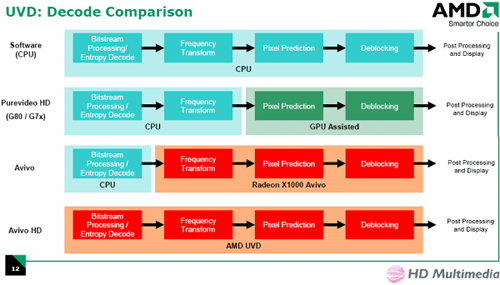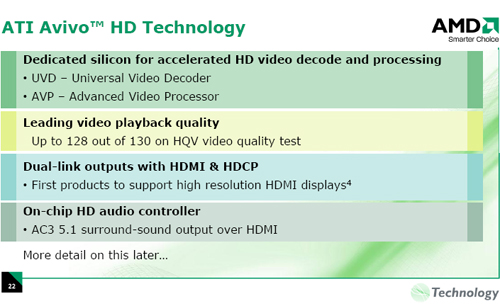
Original Link: https://www.anandtech.com/show/2243
Introduction
There has been a lot of talk over the past week about the fact that the Radeon HD 2900 XT lacks UVD (Universal Video Decode) hardware for HD video decode acceleration on the GPU. We've seen sites from The Tech Report to DailyTech, and even Beyond3D reporting on the situation. While there is much discussion already out there, we would like to provide our take on things.
To recap, the situation is as follows. A huge number of press and channel partners were given the impression by AMD that their R600 GPU used to build the new Radeon HD 2900 XT contained UVD hardware. AMD's press materials are incredibly vague about the issue: they never explicitly state that the HD 2900 XT does or does not physically have UVD hardware. They do list R600 as having AVIVO HD, which they explained includes GPU offload of the entire video decode pipeline in their press materials.

In other slides and presentations, AVIVO HD and UVD have been presented as synonymous. As the entire HD 2000 line is supposed to support AVIVO HD, how could we assume that UVD hardware wasn't included on the GPU?

It seems that AMD is now trying to make it clear that R600 (the 80nm GPU for the HD 2900 XT) does not include UVD, but supports the same video decode features as the X1950. Dedicated hardware makes a big difference in entropy decoding, as we've seen with our G86 testing, but neither NVIDIA nor AMD have top end parts with full spec video decode offloading. The rationale is that high-end GPUs will be paired with CPUs capable of decoding any HD video thrown at them.
With such a huge volume of information to absorb, it seems reasonable to think that some details could get lost in the mix. But, while AMD never actually said anything untrue, they did omit details which could have easily clarified the situation. Walk with us through our experience and see for yourselves how we came to our conclusions.
Our Experience with UVD and R600
It's easy to point to the presentations and say, "look, this is slightly misleading." This doesn't get across the even more convincing interactions we had with AMD personnel over the course of reviewing the HD 2900 XT. Hopefully this will help to illuminate the issue further. I'll have to put a disclaimer on this and say that I don't have a photographic memory and I forgot to bring my diary to the press briefing. This isn't normally the kind of stuff I take notes on for product launches.
At the AMD press event in Tunis, Tunisia (we still can't figure out why we went to Africa to talk about a graphics card), myself and a couple other reviewers had the good fortune of being able to see HD Decode first hand. We watched a side by side comparison of an R6xx based part and a G8x based part with interesting results that mostly pointed out the long way Intervideo and CyberLink have to go in refining their player software. We were under the impression that this was R600, though clarification was not provided.
We talked about UVD and PureVideo, and we were asked if a video decode comparison would be made against NVIDIA hardware for our HD 2900 XT launch article. Upon replying in the affirmative, we got the impression that we should expect the R600 to outperform its competition (the 8800 GTS) in video decode tests. This doesn't seem as certain without UVD, but our marketing speak filters failed to pick up on anything out of the ordinary.
Moving on, we were initially told to expect a driver to enable video decode acceleration shortly before launch. AMD also provided us with a copy of PowerDVD which was said to support AVIVO HD. We did get a newer driver near launch, but in testing it we saw very bad video decode performance. It turns out that we couldn't test video decode at all, as hardware acceleration was not enabled in our press driver. This indicates to us that, even though we saw decode acceleration working in Tunis, AMD was having more trouble than expected in the QA department.
We would expect QA issue with new UVD hardware. If we've got the same video decode hardware as a previous generation part, it seems a little odd to think that we wouldn't have a driver or software to enable the feature.
In going back through our slides for this piece, we noticed that it is explicitly stated that UVD is included on the Radeon Mobility HD 2300. This is an R5xx based part retrofitted with UVD. Of all the parts not to have this new feature, the DX9 class Mobility HD 2300 would have been the one we thought of first. Surely if this part has the new feature, the HD 2900 XT should also include it. The argument for not is, again, that higher end GPUs tend to be paired with CPUs that can handle the workload.
The reason we offer time and again for the fact that G86 and G84 include full video decode while G80 does not is that the slower parts had 6 months more development time. In NVIDIA's case, it makes complete sense that G80 would lack the more refined video decode hardware. For AMD to launch a top to bottom product line and leave a feature like this out of their highest end part is very strange.
So strange, in fact, that combined with all the other experiences we've had with this rather surreal product launch we still just can't help but doubt what we're hearing. To us, the most sensible explanation for all this is that the hardware must be there but is somehow broken - perhaps broken to the point that it will never be fixed on current silicon (i.e. via drivers) and a new spin would be required to address the problems.
In spite of what makes sense to us, AMD has indicated that UVD hardware is not at all present on R600. Their "official" statement has yet to appear, but we'll update this article when/if we get it.
Final Words
For now, we are left with reports that there is no physical UVD hardware in R600. But is this really the case, or was UVD hardware included but broken (reminiscent of the problems NVIDIA had with PureVideo on the 6800 line)? If the physical hardware simply isn't present, the way things have gone seem to indicate that AMD's own staff didn't understand exactly what was going on. For journalists to miss something like this is one thing, but channel partners printing boxes with non-existent features on them is entirely different.
This is more than a little troublesome, but we are awaiting a response from AMD on all the issues we've presented here today. We were hoping to have their response to include here at publication, but we will absolutely update this article when we do hear from AMD.
So where do we stand now? Well, board partners who've already printed boxes with UVD labels and retailers who list UVD as a feature of the HD 2900 XT will need to go back and revise their materials. This is certain to cause plenty of headaches with everyone involved in the making, marketing, retailing, and purchasing of the HD 2900 XT. Journalists have had to go back and correct articles to reflect the lack of UVD support in R600, and everyone is looking to AMD and wondering just what that was all about.
While we might not really think UVD is necessary in a high-end graphics card, just as full video decode might be overkill in an 8800 part, many have lamented the fact that their high-end graphics hardware supports last years video decode feature set. This is true even on G80 hardware where the technology lag makes sense due to the extra development time NVIDIA had with G84/G86. Honestly, for us, the issue is not the lack of the feature; it's the way in which this situation blossomed.
From the beginning, at press briefings, AMD could have grouped R600 with X1000 and separated it from the rest of the R6xx lineup. They had no problems pointing out the differences between G80/G7x and G84/G86. After the fact, with almost every article indicating that UVD was in HD 2900 XT, AMD corrected no one. It took people asking direct questions to start to get real answers. But we still don't feel like we've got the whole story.
With our go-to man for graphics at AMD, Will Willis, having quit shortly after the R600 launch, and most of the other PR people we used to work with from ATI already absent, we have been a little worried about the situation. Losing Will will certainly be a blow for AMD PR, as he was by far the most helpful guy around. Having a key member of the PR team depart just after a launch like this also doesn't feel good. Hopefully, the replacement AMD finds for Will can fill his shoes, and hopefully we will get some answers soon.
We are left with the feeling that AMD wanted this to be ambiguous for as long as possible (whether this is true or not). The reasoning for this is are certainly not attractive, and range from blatant deception (i.e. suggest there's at least one feature on HD 2900 that you couldn't get from 8800 GTS/GTX) to a last minute problem with UVD on R600 that kept them from enabling it. But without answers from AMD, we just can't know what really went on in their minds while all this was going down.







